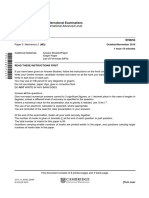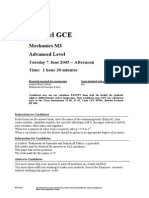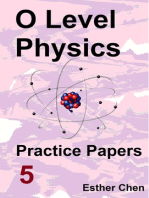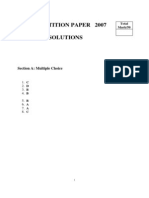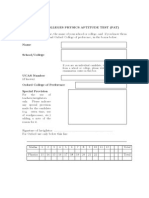A Level Math 51 Nov2013
A Level Math 51 Nov2013
Uploaded by
Ahmad HaikalCopyright:
Available Formats
A Level Math 51 Nov2013
A Level Math 51 Nov2013
Uploaded by
Ahmad HaikalCopyright
Available Formats
Share this document
Did you find this document useful?
Is this content inappropriate?
Copyright:
Available Formats
A Level Math 51 Nov2013
A Level Math 51 Nov2013
Uploaded by
Ahmad HaikalCopyright:
Available Formats
*
6
4
4
9
9
9
8
0
1
4
*
UNIVERSITY OF CAMBRIDGE INTERNATIONAL EXAMINATIONS
General Certicate of Education Advanced Level
MATHEMATICS 9709/51
Paper 5 Mechanics 2 (M2) October/November 2013
1 hour 15 minutes
Additional Materials: Answer Booklet/Paper
Graph Paper
List of Formulae (MF9)
READ THESE INSTRUCTIONS FIRST
If you have been given an Answer Booklet, follow the instructions on the front cover of the Booklet.
Write your Centre number, candidate number and name on all the work you hand in.
Write in dark blue or black pen.
You may use a soft pencil for any diagrams or graphs.
Do not use staples, paper clips, highlighters, glue or correction uid.
Answer all the questions.
Give non-exact numerical answers correct to 3 signicant gures, or 1 decimal place in the case of angles in
degrees, unless a different level of accuracy is specied in the question.
Where a numerical value for the acceleration due to gravity is needed, use 10 ms
2
.
The use of an electronic calculator is expected, where appropriate.
You are reminded of the need for clear presentation in your answers.
At the end of the examination, fasten all your work securely together.
The number of marks is given in brackets [ ] at the end of each question or part question.
The total number of marks for this paper is 50.
Questions carrying smaller numbers of marks are printed earlier in the paper, and questions carrying larger
numbers of marks later in the paper.
This document consists of 4 printed pages.
JC13 11_9709_51/RP
UCLES 2013 [Turn over
w
w
w
.
X
t
r
e
m
e
P
a
p
e
r
s
.
c
o
m
2
1 A particle P of mass 0.3 kg is attached to one end of a light inextensible string of length 0.6 m. The
other end of the string is attached to a xed point O of a smooth horizontal plane. P moves on the
plane at constant speed 5 ms
1
in a circle with centre O. Calculate the tension in the string. [2]
2
A
B
C
O 0.6 m
A uniform frame consists of a semicircular arc ABC of radius 0.6 m together with its diameter AOC,
where O is the centre of the semicircle (see diagram).
(i) Calculate the distance of the centre of mass of the frame from O. [4]
The frame is freely suspended at A and hangs in equilibrium.
(ii) Calculate the angle between AC and the vertical. [2]
3 A particle P of mass 0.8 kg moves along the x-axis on a horizontal surface. When the displacement
of P from the origin O is x m the velocity of P is v ms
1
in the positive x-direction. Two horizontal
forces act on P. One force has magnitude 4e
x
N and acts in the positive x-direction. The other force
has magnitude 2.4x
2
N and acts in the negative x-direction.
(i) Show that v
dv
dx
= 5e
x
3x
2
. [2]
(ii) The velocity of P as it passes through O is 6 ms
1
. Find the velocity of P when x = 2. [5]
4 A small ball B is projected from a point Owith speed 14 ms
1
at an angle of 60 above the horizontal.
(i) Calculate the speed and direction of motion of B for the instant 1.8 s after projection. [5]
The point O is 2 m above a horizontal plane.
(ii) Calculate the time after projection when B reaches the plane. [3]
UCLES 2013 9709/51/O/N/13
3
5
A
B
P
0.4 m
0.3 m
A particle P of mass 0.2 kg is attached to a xed point A by a light inextensible string of length 0.4 m.
A second light inextensible string of length 0.3 m connects P to a xed point B which is vertically
below A. The particle P moves in a horizontal circle, which has its centre on the line AB, with the
angle APB = 90 (see diagram).
(i) Given that the tensions in the two strings are equal, calculate the speed of P. [5]
(ii) It is given instead that P moves with its least possible angular speed for motion in this circle.
Find this angular speed. [3]
6
E
A
B
C
D
1.5 m
0.8 m
30
ABCDis the cross-section through the centre of mass of a uniform rectangular block of weight 260 N.
The lengths AB and BC are 1.5 m and 0.8 m respectively. The block rests in equilibrium with the
point D on a rough horizontal oor. Equilibrium is maintained by a light rope attached to the point A
on the block and the point E on the oor. The points E, A and B lie in a straight line inclined at 30
to the horizontal (see diagram).
(i) By taking moments about D, show that the tension in the rope is 146 N, correct to 3 signicant
gures. [5]
(ii) Given that the block is in limiting equilibrium, calculate the coefcient of friction between the
block and the oor. [4]
[Question 7 is printed on the next page.]
UCLES 2013 9709/51/O/N/13 [Turn over
4
7 A particle P of mass 0.4 kg is attached to one end of a light elastic string of natural length 0.8 m and
modulus of elasticity 32 N. The other end of the string is attached to a xed point O. The particle is
released from rest at O.
(i) Calculate the distance OP at the instant when P rst comes to instantaneous rest. [4]
A horizontal plane is xed at a distance 1 m below O. The particle P is again released from rest at O.
(ii) Calculate the speed of P immediately before it collides with the plane. [3]
(iii) In the collision with the plane, P loses 96% of its kinetic energy. Calculate the distance OP at
the instant when P rst comes to instantaneous rest above the plane, given that this occurs when
the string is slack. [3]
Permission to reproduce items where third-party owned material protected by copyright is included has been sought and cleared where possible. Every reasonable
effort has been made by the publisher (UCLES) to trace copyright holders, but if any items requiring clearance have unwittingly been included, the publisher will
be pleased to make amends at the earliest possible opportunity.
University of Cambridge International Examinations is part of the Cambridge Assessment Group. Cambridge Assessment is the brand name of University of
Cambridge Local Examinations Syndicate (UCLES), which is itself a department of the University of Cambridge.
UCLES 2013 9709/51/O/N/13
You might also like
- Fad User S Guide Rev 0 Dec 2015Document54 pagesFad User S Guide Rev 0 Dec 2015MUHAMMAD ALI100% (2)
- Numerical Methods in Chemical Engineering Using Python® and Simulink®-CRC Press (2023)Document371 pagesNumerical Methods in Chemical Engineering Using Python® and Simulink®-CRC Press (2023)Fabricio VitorinoNo ratings yet
- Fiqh Manhaji Jilid 1Document272 pagesFiqh Manhaji Jilid 1Ahmad Haikal100% (6)
- 10jan M2Document8 pages10jan M2Ahmed NurulNo ratings yet
- Physiology. Hrd.Document549 pagesPhysiology. Hrd.Sʌɩĸʌt PʌʋɭNo ratings yet
- University of Cambridge International Examinations General Certificate of Education Advanced LevelDocument4 pagesUniversity of Cambridge International Examinations General Certificate of Education Advanced LevelHubbak KhanNo ratings yet
- University of Cambridge International Examinations General Certificate of Education Advanced LevelDocument4 pagesUniversity of Cambridge International Examinations General Certificate of Education Advanced LevelHubbak KhanNo ratings yet
- Cambridge International Advanced LevelDocument4 pagesCambridge International Advanced LevelBassem Khalid YasseenNo ratings yet
- Maths1 November 2012 Question Paper 52Document4 pagesMaths1 November 2012 Question Paper 52mrfr4nkofcNo ratings yet
- 9709 w15 QP 53Document4 pages9709 w15 QP 53yuke kristinaNo ratings yet
- A Level Math 41 Nov2013Document4 pagesA Level Math 41 Nov2013Ahmad HaikalNo ratings yet
- 9709 s13 QP 42Document4 pages9709 s13 QP 42Irtiza HussainNo ratings yet
- Higher Mathematics MathematicsDocument8 pagesHigher Mathematics Mathematicstess_15No ratings yet
- University of Cambridge International Examinations General Certificate of Education Advanced Subsidiary Level and Advanced LevelDocument4 pagesUniversity of Cambridge International Examinations General Certificate of Education Advanced Subsidiary Level and Advanced LevelHubbak KhanNo ratings yet
- 9709 s02 QP 5 PDFDocument4 pages9709 s02 QP 5 PDFtess_15No ratings yet
- 9709 s10 QP 43Document4 pages9709 s10 QP 43sriniyfaNo ratings yet
- Cambridge International Advanced LevelDocument4 pagesCambridge International Advanced LevelBassem Khalid YasseenNo ratings yet
- Edexcel GCE: Monday 12 June 2006 Afternoon Time: 1 Hour 30 MinutesDocument4 pagesEdexcel GCE: Monday 12 June 2006 Afternoon Time: 1 Hour 30 MinutesMargarita SatrakiNo ratings yet
- University of Cambridge International Examinations General Certificate of Education Advanced LevelDocument4 pagesUniversity of Cambridge International Examinations General Certificate of Education Advanced LevelKelvin SerimweNo ratings yet
- Edexcel GCE: 6679 Mechanics M3 (New Syllabus) Advanced/Advanced SubsidiaryDocument6 pagesEdexcel GCE: 6679 Mechanics M3 (New Syllabus) Advanced/Advanced SubsidiaryMargarita SatrakiNo ratings yet
- Math m1 Jan 2010Document4 pagesMath m1 Jan 2010Hoang Van NguyenNo ratings yet
- University of Cambridge International Examinations General Certificate of Education Advanced LevelDocument4 pagesUniversity of Cambridge International Examinations General Certificate of Education Advanced LevelPrivate of ScienceNo ratings yet
- Mei Structured Mathematics: Mechanics 3Document71 pagesMei Structured Mathematics: Mechanics 3JW1212No ratings yet
- 9709 s03 QP 4Document4 pages9709 s03 QP 4linusshyNo ratings yet
- 0a.specimen M3Document4 pages0a.specimen M3Margarita SatrakiNo ratings yet
- University of Cambridge International Examinations General Certificate of Education Advanced Subsidiary Level and Advanced LevelDocument4 pagesUniversity of Cambridge International Examinations General Certificate of Education Advanced Subsidiary Level and Advanced Levelahnaf.sharar.rhineNo ratings yet
- Compiled P4 (M1)Document116 pagesCompiled P4 (M1)Roshaan Ashraf0% (1)
- 9709 s10 QP 43Document4 pages9709 s10 QP 43Abrar JahinNo ratings yet
- University of Cambridge International Examinations General Certificate of Education Advanced Subsidiary Level and Advanced LevelDocument4 pagesUniversity of Cambridge International Examinations General Certificate of Education Advanced Subsidiary Level and Advanced LevelLalith77No ratings yet
- University of Cambridge International Examinations General Certificate of Education Advanced LevelDocument4 pagesUniversity of Cambridge International Examinations General Certificate of Education Advanced LevelKelvin SerimweNo ratings yet
- University of Cambridge International Examinations General Certificate of Education Advanced Subsidiary Level and Advanced LevelDocument4 pagesUniversity of Cambridge International Examinations General Certificate of Education Advanced Subsidiary Level and Advanced Levelapurbodebnath5belyNo ratings yet
- University of Cambridge International Examinations General Certificate of Education Advanced LevelDocument8 pagesUniversity of Cambridge International Examinations General Certificate of Education Advanced LevelChristopher BarrettNo ratings yet
- Cambridge International Advanced Subsidiary and Advanced LevelDocument4 pagesCambridge International Advanced Subsidiary and Advanced LevelWarda Ul HasanNo ratings yet
- Mechanics MarchDocument73 pagesMechanics MarchMuhammad FayazNo ratings yet
- Hookes Law From OCR Exam QuestionsDocument38 pagesHookes Law From OCR Exam QuestionsDarren DowlingNo ratings yet
- M2pp Jan13Document96 pagesM2pp Jan13JW1212No ratings yet
- Cambridge International Advanced Subsidiary and Advanced LevelDocument4 pagesCambridge International Advanced Subsidiary and Advanced Levelzuh blackNo ratings yet
- Mathematics: University of Cambridge International Examinations General Certificate of Education Advanced LevelDocument4 pagesMathematics: University of Cambridge International Examinations General Certificate of Education Advanced LevelKelvin SerimweNo ratings yet
- 9709 w15 QP 43Document4 pages9709 w15 QP 43yuke kristinaNo ratings yet
- PaperDocument14 pagesPaperSayan Kumar KhanNo ratings yet
- MathematicsDocument4 pagesMathematicsLalith77No ratings yet
- M1 Nov 03Document5 pagesM1 Nov 03Anwer JalilNo ratings yet
- Additional Mathematics 2009 June Paper 1Document8 pagesAdditional Mathematics 2009 June Paper 1lornarifaNo ratings yet
- University of Cambridge International Examinations General Certificate of Education Advanced Subsidiary Level and Advanced LevelDocument4 pagesUniversity of Cambridge International Examinations General Certificate of Education Advanced Subsidiary Level and Advanced LevelHubbak KhanNo ratings yet
- Mathematics Mm2B Unit Mechanics 2BDocument4 pagesMathematics Mm2B Unit Mechanics 2BAhmed NurulNo ratings yet
- Cambridge International Advanced Subsidiary and Advanced LevelDocument4 pagesCambridge International Advanced Subsidiary and Advanced LevelJohn DoeNo ratings yet
- University of Cambridge International Examinations General Certificate of Education Advanced LevelDocument8 pagesUniversity of Cambridge International Examinations General Certificate of Education Advanced LevelChristopher BarrettNo ratings yet
- GCE Mech M1 M5 Specimen Paper MkschemeDocument46 pagesGCE Mech M1 M5 Specimen Paper MkschemeAlbert RlNo ratings yet
- University of Cambridge International Examinations General Certificate of Education Advanced Subsidiary Level and Advanced LevelDocument4 pagesUniversity of Cambridge International Examinations General Certificate of Education Advanced Subsidiary Level and Advanced LevelPrivate of ScienceNo ratings yet
- Edexcel GCE: 6679 Mechanics M3 Advanced/Advanced SubsidiaryDocument6 pagesEdexcel GCE: 6679 Mechanics M3 Advanced/Advanced SubsidiaryMargarita SatrakiNo ratings yet
- 9709 s11 QP 42Document4 pages9709 s11 QP 42sohailbabarNo ratings yet
- 9709 s15 QP 43Document4 pages9709 s15 QP 43Syakir AkeNo ratings yet
- AITSDocument27 pagesAITSSiddharth Gangal100% (2)
- INPHO Question Paper 04-02-2024Document9 pagesINPHO Question Paper 04-02-2024Safiqul IslamNo ratings yet
- Minor 1Document3 pagesMinor 1qwertyapoorvfiitjeeNo ratings yet
- Edexcel GCE: Tuesday 7 June 2005 Afternoon Time: 1 Hour 30 MinutesDocument4 pagesEdexcel GCE: Tuesday 7 June 2005 Afternoon Time: 1 Hour 30 MinutesMargarita SatrakiNo ratings yet
- University of Cambridge International Examinations General Certificate of Education Advanced Subsidiary Level and Advanced LevelDocument4 pagesUniversity of Cambridge International Examinations General Certificate of Education Advanced Subsidiary Level and Advanced LevelHubbak KhanNo ratings yet
- M1pp Jan13Document99 pagesM1pp Jan13JW1212No ratings yet
- Method of Moments for 2D Scattering Problems: Basic Concepts and ApplicationsFrom EverandMethod of Moments for 2D Scattering Problems: Basic Concepts and ApplicationsNo ratings yet
- As Competition Paper 2008 Solutions: Total Mark/50Document10 pagesAs Competition Paper 2008 Solutions: Total Mark/50Ahmad HaikalNo ratings yet
- A Level Math 41 Nov2013Document4 pagesA Level Math 41 Nov2013Ahmad HaikalNo ratings yet
- As Competition Paper 2007 Solutions: Section A: Multiple ChoiceDocument8 pagesAs Competition Paper 2007 Solutions: Section A: Multiple ChoiceAhmad HaikalNo ratings yet
- For Candidates Applying For Physics, and Physics and PhilosophyDocument8 pagesFor Candidates Applying For Physics, and Physics and PhilosophyAhmad HaikalNo ratings yet
- Pat 2012 Paper PDF 10581Document28 pagesPat 2012 Paper PDF 10581Ahmad HaikalNo ratings yet
- Johns Hopkins Financial StatementDocument2 pagesJohns Hopkins Financial StatementAhmad HaikalNo ratings yet
- Presentation 1Document2 pagesPresentation 1Ahmad HaikalNo ratings yet
- Rumusan Penilaian Kokurikulum SmkmaDocument104 pagesRumusan Penilaian Kokurikulum SmkmaAhmad HaikalNo ratings yet
- 4spi 2012Document3 pages4spi 2012Ahmad HaikalNo ratings yet
- Blood Flow PhysicsDocument17 pagesBlood Flow PhysicsAhmad Haikal0% (1)
- W1 EnvironDocument15 pagesW1 Environnikita wNo ratings yet
- Chemistry v1.00 For TI-89 Flash Application Senior Programmer: Matt AcostaDocument5 pagesChemistry v1.00 For TI-89 Flash Application Senior Programmer: Matt Acostahasta abajo garganta profundaNo ratings yet
- CAT Eleco ConectorsDocument93 pagesCAT Eleco ConectorsJarrod DebonoNo ratings yet
- Week 11 Column Direct LoadDocument37 pagesWeek 11 Column Direct LoaddarshanNo ratings yet
- Measuring Vibration - Page 6Document2 pagesMeasuring Vibration - Page 6sachin nagavkarNo ratings yet
- Catalogue+Data SheetDocument16 pagesCatalogue+Data Sheethossein15No ratings yet
- Question 3 Assignment Module 7Document5 pagesQuestion 3 Assignment Module 7Bakhtawar QurbanNo ratings yet
- GorgonDocument22 pagesGorgonMMatute FDNo ratings yet
- 024.5.120 Bài tập 1.2 MAN B&W 6S60MC-CDocument30 pages024.5.120 Bài tập 1.2 MAN B&W 6S60MC-CKhải Nguyễn MinhNo ratings yet
- L16 - BRG - Gaussian Dispersion Model For Point SourceDocument44 pagesL16 - BRG - Gaussian Dispersion Model For Point SourceDimpi ShahNo ratings yet
- Mooring Analysis FOWT South KoreaDocument200 pagesMooring Analysis FOWT South KoreaShadhin SudhershanNo ratings yet
- Case Study South Moravian RegionDocument6 pagesCase Study South Moravian RegionZoya zafarNo ratings yet
- 4 - Numerical Methods Ex. Module-6-BDocument5 pages4 - Numerical Methods Ex. Module-6-BRaju SinghNo ratings yet
- Unit 5 Izekeeva Gaukhargul 2Document5 pagesUnit 5 Izekeeva Gaukhargul 2aynura.tukenovaNo ratings yet
- RecrystallizationDocument4 pagesRecrystallizationمحمد اسماعيل يوسفNo ratings yet
- PhEn602 Spring09 Notes5Document89 pagesPhEn602 Spring09 Notes5Anonymous cZ0Sn4hxF100% (1)
- Blended or Hybrid LearningDocument4 pagesBlended or Hybrid LearningThandar Swe ZinNo ratings yet
- Proving Shannon's Second TheoremDocument18 pagesProving Shannon's Second Theoremhoeelin8256No ratings yet
- 14 PDFDocument7 pages14 PDFWesley Anne Puso RoseteNo ratings yet
- CASE: A Tragic Choice - Jim and The Natives in The JungleDocument1 pageCASE: A Tragic Choice - Jim and The Natives in The JungleCatherine VenturaNo ratings yet
- Book or Retail Store PositionDocument3 pagesBook or Retail Store PositionFernanda BonesioNo ratings yet
- Participle-Adjective Formation in Modern Greek: Dept. of Computational Linguistics Universität Des Saarlandes (Uds)Document10 pagesParticiple-Adjective Formation in Modern Greek: Dept. of Computational Linguistics Universität Des Saarlandes (Uds)vamshichandraNo ratings yet
- Crusher Plant: Machine Rocks Gravel TangentDocument3 pagesCrusher Plant: Machine Rocks Gravel Tangentanil kumarNo ratings yet
- CECC483-Steel Design - NSCP 2015 - Rev0Document12 pagesCECC483-Steel Design - NSCP 2015 - Rev0Venz Gregory RosellNo ratings yet
- CAT Actual Paper 2020 Slot-1Document13 pagesCAT Actual Paper 2020 Slot-1Arjan ChatterjeeNo ratings yet
- Kafd A1 111 Comn NSF XXXXX WSP Phe DWG 00014Document1 pageKafd A1 111 Comn NSF XXXXX WSP Phe DWG 00014YazNo ratings yet
- Visvesvaraya Technological University, BELGAUM 590014Document12 pagesVisvesvaraya Technological University, BELGAUM 590014Yuvraj SinghNo ratings yet









